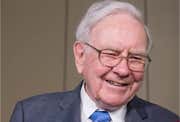The interesting thing about the value investors who have been especially successful is that they have all achieved extraordinary returns while investing different amounts of money in different stocks at different times. While many of them worked or studied with each other at some point, and their basic investment approaches are founded on the same principles, they have achieved their stellar results independently. Here are six value investors whose names you should know.
1. Benjamin Graham
INSERT IMAGE FROM https://commons.wikimedia.org/wiki/File:Benjamin-Graham-fundamental.jpg
All value investors trace their roots back to Benjamin Graham (1894–1976), the father of value investing. He authored the two books that form the foundation of value investing theory: “Security Analysis” (with David Dodd) and “The Intelligent Investor.” He developed the idea of buying stocks below their intrinsic value to limit downside risk and promoted the idea that stocks often trade at prices that do not reflect their intrinsic value. Graham’s techniques inspired Warren Buffett and have informed Buffett’s investment strategy for decades. Graham worked as an investment manager and as a lecturer at Columbia University.
2. Warren Buffett
Warren Buffett was born in 1930. He was Graham’s student at Columbia and later his employee. Buffett thinks of buying stocks as buying companies (indeed, he is wealthy enough that he sometimes buys entire companies). He also has an indefinite time horizon for his investments. He made his first investment at age 14 and became a millionaire around age 30.
Along with investor and businessman Charlie Munger, Buffett purchased a textile company called Berkshire Hathaway (NYSE:BRK.A, BRK.B) in 1965 and used its cash flows to invest in companies such as Coca Cola (NYSE:KO) and American Express (NYSE: AXP) and to purchase entire companies such as GEICO. He remains its CEO as of 2017 and has become one of the wealthiest men in the world through value investing. In 2017, Forbes estimated his net worth at $80.2 billion. (Learn more in Think Like Warren Buffett.)
3. Seth Klarman
Low-profile billionaire hedge-fund manager Seth Klarman, born in 1957, founded an investment partnership called the Baupost Group that has lost money in only 3 of the last 34 years since its founding in 1983. He has achieved these stellar returns even though he sometimes holds large amounts of cash (up to 50% of his portfolio) and even returns cash to investors when value investing opportunities are scarce. His fund’s annual returns have averaged 16.4% through 2015, and he managed $30 billion as of early 2017. He is risk-averse and bases his value-stock picks on companies’ liquidation value. He is also willing to think outside the box and choose investments other than U.S. stocks that other investors might overlook or fear.
According to his 2010 Baupost Group letter, the keys to long-term investment success are to have “truly long-term capital; a flexible approach that enables you to move opportunistically across a broad array of markets, securities, and asset classes; deep industry knowledge; strong sourcing relationships; and a solid grounding in value investing principles.” He also believes in looking at what other investors are doing to consider what he can do differently to outperform them. His only book is “Margin of Safety, Risk Averse Investing Strategies for the Thoughtful Investor,” published in 1991.
4. Walter Schloss
Early in his career, Walter Schloss (1916–2012) worked with Buffett at Graham’s firm, Graham-Newman. In 1955, he started his own investment management firm. In 50 years as an investment manager, he averaged about 15% annual returns after fees. He used company financial statements and the investment publication Value Line for much of his investment research. He sought companies where management was a major stockholder, debt was low and the stock was trading at a discount to book value.
Strategies Schloss used successfully included shorting stocks and holding large amounts of cash when he didn’t see good investment opportunities. He also diversified beyond what some value investors would recommend, sometimes owning more than 100 stocks at a time. Schloss never went to college, proving once again that you don’t need a university degree to make lots of money and you don’t need to major in finance to become a great investor. (For further reading, see The Walter Schloss Approach to Investing.)
5. Christopher H. Browne
Christopher H. Browne (1946–2009) worked at Tweedy, Browne Company, an investment firm founded by his father, Forrest Tweedy, for 40 years. Tweedy, Browne’s investment philosophy is based on Graham’s teachings. In fact, Graham traded through the company for three decades. Buffett was also a customer; it was through Tweedy, Browne that he purchased Berkshire Hathaway. The company had a relationship with Schloss, too.
Initially a brokerage, Tweedy, Browne became an investment firm in 1975 and later developed a handful of value-oriented mutual funds that have outperformed the S&P 500. In 1983, the company started investing in international value stocks. The company’s managing directors pride themselves on owning the same investments that they manage for their clients.
(Source: https://tweedy.com/about/index.php)
6. Irving Kahn
Irving Kahn (1905–2015, and no, that’s not a typo) was yet another Graham disciple — he even worked as his teaching assistant at Columbia and contributed to Graham’s book, “Security Analysis,” published in 1934. Kahn started working on Wall Street in 1928, and along with Graham and other investors, he founded the New York Society of Securities Analysts in 1937. His philosophy was that the frenzied trading of stocks on Wall Street is disconnected from the facts about the underlying businesses and that patience in investing is a virtue. He was a conservative investor, holding about 50% of his assets in cash and the other 50% in stocks.
Kahn founded the New York-based private investment firm Kahn Brothers Advisors in 1978 with two of his sons. The company adheres to Graham and Dodd’s margin of safety principle and invests in businesses that are priced below their true value. The managers focus on investments in seasoned businesses in depressed but well-established economic sectors. However, rather than focusing on large-cap stocks like Buffett does, Kahn Brothers focuses on small and medium-sized companies and even invests in securities through the over-the-counter market. The company today manages $1 billion.
Like Tweedy, Browne, the firm’s managers purchase the same investments for themselves that they purchase on behalf of their clients. Also, Kahn Brothers’ analysis emphasizes balance sheet data over income statement data. They seek out securities selling at a discount to net working capital per share and adjusted per share book value and that have a low price-to-earnings ratio. (A company’s efficiency, financial strength and cash-flow health show in its management of working capital. Learn how in Working Capital Works.)
In the next section, we’ll discuss options for incorporating value investing into your portfolio without doing all the usual grunt work.
Value Investing: Couch Potato Value Investing
-
 Managing Wealth
Managing WealthBenjamin Graham: The intelligent investor
Benjamin Graham, while best known as Warren Buffett's mentor, was a legendary investor in his own right. Learn more about his story. -
 Investing
Investing3 Misconceptions about Warren Buffett
Learn why Warren Buffett is the man behind the curtain and how he is misunderstood regarding the ways he has adapted and changed his investing approach over the years. -
 Investing
InvestingBuffett's 3 Best Rules For Stock Investing
Smiling Oracle: Buffett's investing rules have resulted in 20.9% annual returns -
 Managing Wealth
Managing WealthWarren Buffett's Bear Market Maneuvers
This esteemed investor rarely changes his long-term investing strategy, no matter what the market does. -
 Insights
InsightsEconomist Guide: 4 Lessons Warren Buffett Teaches Us
Learn how Warren Buffett's most famous investment advice can teach investors to manage their own money and practices. -
 Investing
InvestingSuccessful Investments Warren Buffett Passed On (GOOGL, XRX)
Even Warren Buffett, the greatest investor of our time, has made many errors. Investors can learn from his mistakes of omission and commission. -
 Investing
InvestingValue Investing: Why You're Doing It Wrong
Benjamin Graham, the original value investor, would be 123 today. He might not like what he sees.



